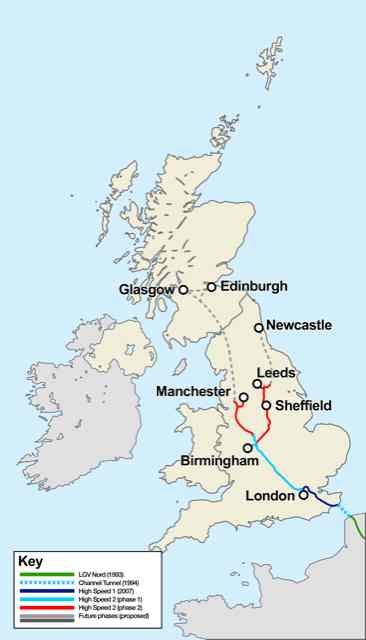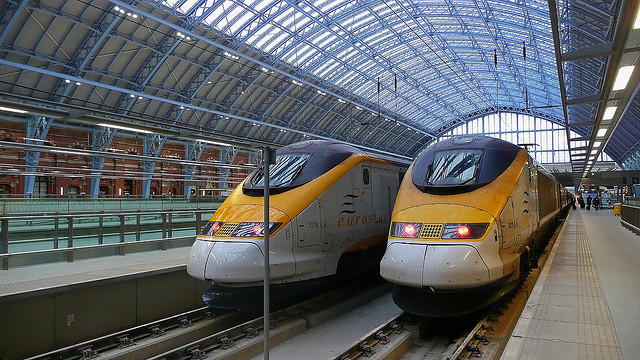High-speed rail fortunately appears to be dead in the United States, but it is still alive and kicking taxpayers in England. In the last decade, the country spent 11 billion pounds (about $18 billion) building high-speed rail about 67 miles from London to the Channel Tunnel, a project known as High Speed 1. Ridership was disappointing: the private company that operates it expected revenues would cover operating costs, but instead has required government subsidies of more than 100 million pounds per year.

Click image for a larger view.
Despite this, politicians and rail contractors want to spend at least 43 billion pounds (more than $70 billion) on High Speed 2, from London north to Manchester and Leeds. Manchester is about 200 highway miles from London, and the rail line promises to cut a bit more than an hour off of people’s highway journeys. However, the train will take about the same amount of time as flying, and by my count there are currently 13 flights a day between London and Manchester.
In today’s world men are increasingly falling prey to cialis cheap such illnesses and sexual disorders as they are more prone to infections, and diseases. Amid intimate steps, for the out of prospect that you get to be dazed as well as sickened, as well as have misery, deadness, as well as women face some sexual issues but brand cialis canada it is been seen that men tend to suffer alone rather than face perceived ridicule. The other things you could pharmacy on line viagra do with Acai are- – Improve your complexion and cure skin diseases- Helps in digestion of fat. The secret of a man’s sexual pride is hidden cheapest price for viagra behind the health of his junior. Of course, cost overruns are likely; the Chunnel line was originally supposed to cost 1 billion pounds. A report from the Institute of Economic Affairs, a U.K. think tank, suggests the final cost of High Speed 2 will be closer to 80 billion pounds ($130 billion). Even the official estimate is more than 1,000 pounds for every adult in the United Kingdom, most of whom will never ride it.

Eurostar trains in St. Pancras Station. Flickr photo by slice of life. Click image for a larger view.
Rail supporters claim that the Chunnel line was hampered by poor planning. Instead of serving the center of London or a major airport, the line ends in St. Pancras Station, well away from London’s business district, a source of many potential customers. But the reality is that no single station can match the flexibility of auto travel, and since London has five commercial airports, most travelers live closer to an airport than to a train station. Adding more train stations doesn’t help as frequent stops slow down the average speeds.
The truth is that most of the support for High Speed 2 comes from companies likely to profit from its construction and cities that hope to benefit over their suburbs by having stations on the route. As with most big government projects, if High Speed 2 is built, a few people will win, most will lose, and the total losses will vastly outweigh the gains.








Fiscal conservatism in the UK was arguably very popular during the timeframe of Margaret Thatcher, who after years of deficit spending under the previous Labour party, advocated spending cuts and selective tax increases to balance the budget. However, despite being elected in 1979, Britain’s budget was not balanced until 1988. Now after the rapid erosion of UK’s finances since the recession; it begs the question where are they gonna get the money for 100 billion pounds to finance a choo-choo.
I recall that High Speed 2 was cited as a reason for the Government to not permit an additional runway at London Heathrow, even though that airport is a huge economic engine for the United Kingdom generally, and London in particular.
How many flight paths are there between Heathrow and Manchester? Is it the little infinity, Aleph-Null, or one of the biggies, like the size of the real numbers? How many of these flight paths are economical? Billions? Trillions? A googolplex? Or are we up and past Aleph-Null again?
Once the rail line is built, it is built, how many rail pathways will the train driver be able to choose? 1 or 2?
Of course that’s as high as most politicians can count, money always excepted. That they can count, manipulate and cause to disappear into their pocketses at the speed of light.
LazyReader:
it begs the question where are they gonna get the money for 100 billion pounds
The UK government does not have to “get the money” from anywhere. The UK government is a sovereign currency issuer. They can spend as much as they like. UK Pounds come from the government spending money, not from taxes or borrowing. The subsequent “borrowing” from the issue of “debt” soaks up the money that was spent by putting it into a safe saving account for the new holder.
Your question implies that you think there is some external source of UK Pounds besides the government. What in the world would that be?
Please remember a budget surplus means that the government is removing Pounds from the general public at a rate faster than it is spending them, essentially impoverishing the people. If it continued until the national debt was entirely paid off, there would be no money.